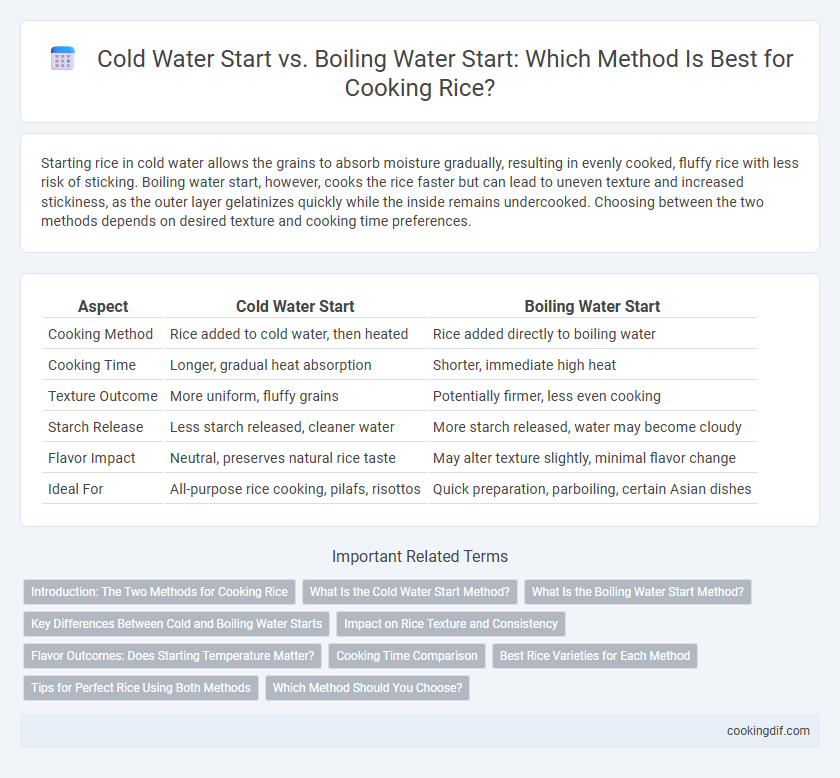Starting rice in cold water allows the grains to absorb moisture gradually, resulting in evenly cooked, fluffy rice with less risk of sticking. Boiling water start, however, cooks the rice faster but can lead to uneven texture and increased stickiness, as the outer layer gelatinizes quickly while the inside remains undercooked. Choosing between the two methods depends on desired texture and cooking time preferences.
Table of Comparison
| Aspect | Cold Water Start | Boiling Water Start |
|---|---|---|
| Cooking Method | Rice added to cold water, then heated | Rice added directly to boiling water |
| Cooking Time | Longer, gradual heat absorption | Shorter, immediate high heat |
| Texture Outcome | More uniform, fluffy grains | Potentially firmer, less even cooking |
| Starch Release | Less starch released, cleaner water | More starch released, water may become cloudy |
| Flavor Impact | Neutral, preserves natural rice taste | May alter texture slightly, minimal flavor change |
| Ideal For | All-purpose rice cooking, pilafs, risottos | Quick preparation, parboiling, certain Asian dishes |
Introduction: The Two Methods for Cooking Rice
Starting rice in cold water allows grains to absorb moisture gradually, promoting even cooking and preventing surface starch from gelatinizing too quickly. Boiling water start immediately subjects rice to high heat, which can lead to faster cooking but increases the risk of uneven texture and potential sticking. Each method influences the final texture and flavor profile depending on rice variety and cooking equipment used.
What Is the Cold Water Start Method?
The cold water start method for cooking rice involves placing the rice in cold water before turning on the heat, allowing the grains to absorb water gradually as the temperature rises. This technique promotes even cooking and helps prevent the outer layer from becoming mushy, resulting in straighter, fluffier grains. Cold water start is particularly effective for long-grain varieties such as basmati or jasmine rice, where preserving texture is essential.
What Is the Boiling Water Start Method?
The boiling water start method for cooking rice involves adding rice to water at its boiling point instead of starting with cold water. This technique reduces cooking time and helps prevent overcooking or mushy texture by allowing more precise control over the absorption process. Ideal for long-grain varieties like basmati, the boiling water start method ensures fluffy, separate grains and consistent results.
Key Differences Between Cold and Boiling Water Starts
Starting rice cooking with cold water allows even absorption and gradual gelatinization of starches, resulting in tender, fluffy grains. Boiling water start accelerates the cooking process, often producing firmer, less sticky rice with a slightly different texture due to rapid starch swelling. The choice between cold and boiling water methods directly influences cooking time, texture, and starch release, impacting dishes like pilaf or risotto.
Impact on Rice Texture and Consistency
Starting rice cooking with cold water results in gradual heat absorption, promoting even starch gelatinization and yielding tender, fluffy grains with a consistent texture. In contrast, boiling water start accelerates surface cooking, often causing outer layers to firm up quickly while the interior remains less cooked, leading to uneven texture and potential grain separation. Understanding these effects helps optimize rice preparation for desired consistency and mouthfeel.
Flavor Outcomes: Does Starting Temperature Matter?
Starting rice in cold water allows the grains to absorb moisture gradually, leading to a more even texture and enhanced natural sweetness. Boiling water start quickly seals the starches on the surface, which can result in a firmer exterior but sometimes a less flavorful interior. The choice between cold water start and boiling water start significantly influences the flavor profile and mouthfeel of cooked rice.
Cooking Time Comparison
Starting rice cooking with cold water generally increases cooking time by 5-10 minutes compared to boiling water start because the grains gradually absorb heat and water. Boiling water start rapidly initiates the starch gelatinization process, reducing overall cooking time and yielding more evenly cooked rice. Temperature control is crucial to prevent overcooking or undercooking, regardless of the initial water temperature.
Best Rice Varieties for Each Method
Jasmine and Basmati rice are ideal for boiling water start due to their long grains and fragrant aroma that enhance texture when cooked rapidly. Sushi rice and short-grain varieties respond best to cold water start, allowing gradual heat absorption and resulting in sticky, tender grains perfect for sushi and risotto. For best cooking results, choose rice types based on the start method to maximize flavor and texture.
Tips for Perfect Rice Using Both Methods
Starting rice in cold water ensures even absorption, preventing mushy grains and resulting in a fluffy texture ideal for pilaf or fried rice dishes. Boiling water start reduces cooking time and locks in nutrients, producing firmer, separate grains perfect for sushi or salads. Rinsing rice thoroughly and adjusting water ratios according to the method are essential tips for achieving consistent, perfect rice every time.
Which Method Should You Choose?
Starting rice cooking with cold water allows gradual absorption and even heat distribution, resulting in tender, fluffy grains ideal for long-grain varieties. Boiling water start accelerates cooking time and helps achieve a firmer texture, preferred in recipes requiring distinct, separate grains like pilaf. Choosing between methods depends on rice type and desired texture; cold water suits delicate, aromatic rices, while boiling water benefits heartier, sturdier grains.
Cold water start vs Boiling water start for rice Infographic

 cookingdif.com
cookingdif.com